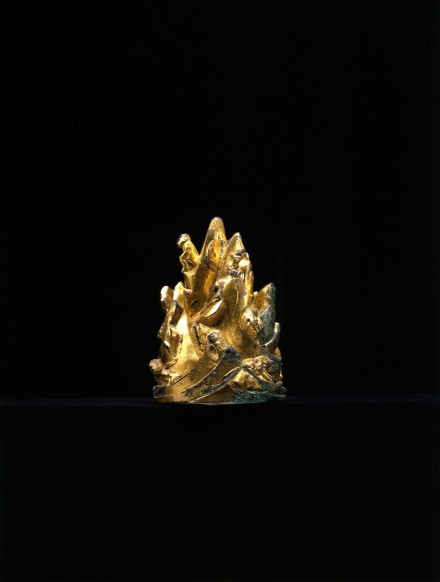J.J. Lally & Co., Oriental Art / New York City, New York
MenuPast Exhibition
Bronze and Gold in Ancient China
March 24 - April 12, 2003

17.
A GILT BRONZE MOUNTAIN-FORM WEIGHT
Early Western Han Dynasty, Late 3rd/Early 2nd Century B.C.
heavily cast as a high mountain rising from undulating cliffs around the circular base to form numerous jagged peaks inhabited by tigers, bears and wild boars, and with a monkey seated near the highest peak and a magic tortoise near the base, the many cliffs embellished with incised ribbing along their ridges, and the base with a cluster of three trees in relief, the interior filled with lead amalgam and the richly gilded surface with some worn spots revealing the dark metal and with scattered areas of bright green encrustation.
Height 2 7⁄8 inches (7.3 cm)
The sacred realm in the high mountains where men encountered immortal spirits and mythical beasts among the clouds was an ancient concept of shamanism in China which became a very popular theme in literature and art during the Han dynasty. For an extensive discussion of this theme with illustrations of many Han bronze and pottery works of art, see the catalogue of the exhibition entitled Sacred Mountains in Chinese Art by Kiyohiko Munakata, University of Illinois, 1991.
A Western Han gilt bronze finial for a zither string anchor cast with a similar depiction of jagged mountain peaks inhabited by wild beasts, from the collection of Shelby White and Leon Levy, was exhibited at the Metropolitan Museum of Art, New York and illustrated in the catalogue by Bunker, Watt and Sun, Nomadic Art of the Eastern Eurasian Steppes: The Eugene V. Thaw and Other New York Collections, New York, 2002, no. 179, p. 188-189.
17.
A GILT BRONZE MOUNTAIN-FORM WEIGHT
Early Western Han Dynasty, Late 3rd/Early 2nd Century B.C.
Height 2 7⁄8 inches (7.3 cm)